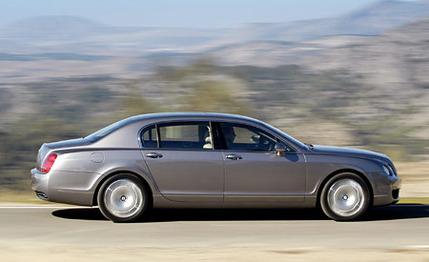
 First Drive Review
First Drive Review
At more than twice Italy's 81-mph national autostrada speed limit, the Bentley Continental Flying Spur is still accelerating with enthusiasm. Despite its vast 5500-pound mass, the new four-door version of the Continental GT is endowed with a remarkably lofty top speed. How lofty? Try 195 miles per hour, according to Bentley. Lose it at top velocity, and you're dealing with enough kinetic energy to knock down the Trump Tower.
Big luxocars with 155-mph speed limiters are abundant. So if a manufacturer wants to set itself apart-and charge more than $170,000 for its car-a figure like 195 mph reads well on the pedigree. Speaking of pedigree, the Flying Spur revives the name of another icon that appeared first as a coupe, the R-type Continental, in 1952; then as a four-door, the Continental Flying Spur, in 1957.
Pretty snooty bloodlines, you'd think, except for the fact that this Bentley has more Volkswagen Group DNA than anything else. The 6.0-liter W-12 engine design, four-wheel-drive system, and basic suspension architecture are all from the VW Phaeton-not too surprising, since Bentley is a VW subsidiary. Yet Bentley product manager Ken Scott is quick to point out that the direct component carry-over is only 25 percent and that the engineers at Crewe, in England, dictated much of the car's engine-block design. (Bentley builds the engines at Crewe.)
The basic concept remains a pair of siamesed narrow-angle V-6 blocks pedaling together at the insistence of two separate turbochargers, their efforts rewarded with 551 horsepower and 479 pound-feet of torque from 1600 rpm. It's not so much a torque curve as it is a plateau.
The output numbers are identical to those of the GT, which shares much of the Flying Spur's structure and drivetrain. What's different is the new four-door coachwork. The car is 19.8 inches longer than the GT, with a wheelbase stretched 12.6 inches. The result is an extremely spacious rear passenger compartment and a well-proportioned, if lengthy, profile.
Buyers have the option of acquiring a four- or five-seat layout, with a suitably opulent center console added in four-seat versions. Opulence is the name of the game here. The car requires more than 11 cowhides to wrap its various surfaces, and the stitching is nothing short of uncanny in its precision. The wood veneer has a mirror-smooth finish, and all the controls have billet-like solidity in their movements.
The ultramodern and the traditional live side by side in this car. Small mushroom-shaped metal pull switches open and shut the vents with a satisfying damped thud, and they populate a dashboard studded with the latest electronic equipment.
Well, maybe the navigation system isn't quite that modern, with operation that seems hopelessly slow and ponderous. And at 10 mpg in town, you really don't need to go around the block again.
The Bentley people took pains to minimize the inevitable weight gain that came with two more doors and nearly 20 inches of bodywork by using aluminum for the rear-suspension subframe and front-suspension uprights. Thus, they claim a weight increase of only about 200 pounds. In the process the engineers revised the steering system for what they say is better feel than in the GT. They're correct. The Flying Spur has excellent on- and off-center feel and goes precisely where you point it, with handling that is deft enough to belie the car's weight. Progressive understeer and stability control are there to rein in a chauffeur's exuberance.
That Phaeton platform works well, particularly when you have the kind of engineering investment a vehicle like this allows. A generous budget also enabled the engineers to seek a unique exhaust note for the Flying Spur-one that purrs discreetly in most circumstances but also produces a mellifluous ripping note when the pedal is thrust deep into the carpet.
As you'd expect from a marque with this heritage, the detailing is exquisite. The wheel patterns, the numerous winged and ringed Bentley badges, the intricate grille mesh, the artful use of LEDs in the taillights-all remind the owner of her or his special status. And in case you're still thinking about that claimed 195-mph top speed, here's a reassuring specification: The Flying Spur's front brake rotors are a fraction under 16 inches in diameter and just may be the largest on any production car today.
Flying is all very well, but you have to stop sometime.